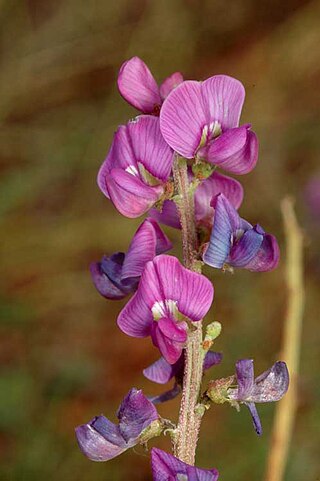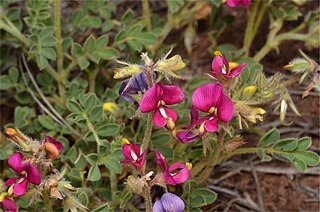
Swainsona behriana, commonly known as Behr's swainsona, is a species of flowering plant in the family Fabaceae and is endemic to south-eastern continental Australia. It is a prostrate or low-growing perennial herb with imparipinnate leaves usually with 9 to 13 narrowly elliptic to egg-shaped leaflets with the narrower end towards the base, and racemes of 2 to 7 purple flowers.
Swainsona adenophylla, commonly known as violet swainson-pea or violet Darling pea, is a species of flowering plant in the family Fabaceae and is endemic to arid areas of central Australia. It is a slender, erect or spreading perennial herb with imparipinnate leaves with three to nine linear to narrowly egg-shaped leaflets, and racemes of pink or purplish flowers in racemes of ten to twenty.

Swainsona affinis, commonly known as common poison pea, is a species of flowering plant in the family Fabaceae and is endemic to arid areas of inland Australia. It is a prostrate perennial herb with imparipinnate leaves with 7 to 25 broadly elliptic leaflets, and racemes of purple, pink, yellow or white flowers.

Swainsona brachycarpa, commonly known as slender swainson-pea, is a species of flowering plant in the family Fabaceae and is endemic to eastern Australia. It is a prostrate or ascending perennial herb with imparipinnate leaves usually with 9 to 13 egg-shaped to narrowly elliptic or egg-shaped leaflets, and racemes of up to 12 white, purple or dark red flowers.
Swainsona bracteata is a species of flowering plant in the family Fabaceae and is endemic to eastern Australia. It is a perennial herb with imparipinnate leaves usually with 19 to 25 narrowly egg-shaped leaflets, and racemes of about 20 white, pale pink or pale purple flowers.
Swainsona cadellii is a species of flowering plant in the family Fabaceae and is endemic to inland New South Wales. It is a shrubby perennial with imparipinnate leaves usually with 5 to 15 mostly narrowly egg-shaped leaflets, and racemes of 15 to 20 white, pink or purple flowers.

Swainsona campestris is a species of flowering plant in the family Fabaceae and is endemic to arid areas of southern Australia. It is an erect perennial herb with imparipinnate leaves with 9 to 11 linear to narrowly lance-shaped leaflets, and racemes of pink or purple flowers in racemes of 5 to 10.

Swainsona campylantha, commonly known as Gilgai Darling pea, is a species of flowering plant in the family Fabaceae and is endemic to inland areas of Australia. It is a low-growing perennial with imparipinnate leaves usually with up to 7 narrowly lance-shaped to narrowly elliptic leaflets, and racemes of 2 to 10 pink to purple flowers.
Swainsona complanata is a species of flowering plant in the family Fabaceae and is endemic to northern Western Australia. It is an erect, annual herb with imparipinnate leaves usually with up to 13 narrowly egg-shaped leaflets with the narrower end towards the base, and racemes of up to 20 mauve to maroon flowers.
Swainsona cornuta is a species of flowering plant in the family Fabaceae and is endemic to the west of Western Australia. It is a low-lying, annual or perennial herb with imparipinnate leaves usually with about 7 elliptic leaflets and racemes of 3 to 7 purple flowers.
Swainsona dictyocarpa is a species of flowering plant in the family Fabaceae and is endemic to central areas of South Australia. It is a small erect perennial herb with imparipinnate leaves with 3 to 7 elliptic leaflets, and racemes of purple flowers in racemes of 2 to 6.
Swainsona eremaea is a species of flowering plant in the family Fabaceae and is endemic to South Australia. It is a low-growing, spreading, probably perennial plant with imparipinnate leaves with 5 to 11 linear, oblong to broadly wedge-shaped leaflets, and racemes of bright red to brown or yellow flowers in racemes of 5 to 20.

Swainsona flavicarinata is a species of flowering plant in the family Fabaceae and is endemic to inland areas of continental Australia. It is a prostrate to more or less erect perennial herb, with imparipinnate leaves with 5 to 9 egg-shaped leaflets with the narrower end towards the base, and racemes of purple, red or pink flowers in racemes of 3 to 15.
Swainsona forrestii is a species of flowering plant in the family Fabaceae and is endemic to the central northern Western Australia. It is an erect or spreading, single-stemmed annual herb, with imparipinnate leaves with about 13 to 17 narrowly egg-shaped or narrowly ellipitic leaflets, and racemes of dark brownish red to purple or pink flowers in racemes of 30 or more.
Swainsona fraseri is a species of flowering plant in the family Fabaceae and is endemic to eastern Australia. It is a perennial plant with imparipinnate leaves with mostly 21 to 24 ellipitic leaflets, and racemes of 20 or more pink to purple flowers.
Swainsona fuscoviridis is a species of flowering plant in the family Fabaceae and is endemic to South Australia. It is a perennial plant with many stems and imparipinnate leaves with mostly 7 or 9 ellipitic, linear or egg-shaped or lance-shaped leaflets, and racemes of 12 to 20 purple flowers.
Swainsona gracilis is a species of flowering plant in the family Fabaceae and is endemic to the south-west of Western Australia. It is a prostrate or ascending perennial herb with imparipinnate leaves with up to 15 wedge-shaped or narrowly oblong leaflets, and racemes of up to 4 purple or blue flowers.
Swainsona halophila is a species of flowering plant in the family Fabaceae and is endemic to inland areas of Western Australia. It is usually a prostrate annual herb with imparipinnate leaves with 9 to 13 egg-shaped to broadly wedge-shaped leaflets, and racemes of 2 to 9 purple flowers.
Swainsona incei is a species of flowering plant in the family Fabaceae and is endemic to inland Western Australia. It is an erect or ascending annual, sometimes perennial herb with imparipinnate leaves with 5 to 9 lance-shaped to elliptic leaflets, and racemes of 2 to 30 purple flowers.
Swainsona katjarra, commonly known as Birriliburu swainsona, is a species of flowering plant in the family Fabaceae and is endemic to inland Western Australia. It is an erect annual herb with imparipinnate leaves with 4 to 6 lance-shaped to egg-shaped to elliptical leaflets, and racemes of 15 to 25 magenta flowers.





